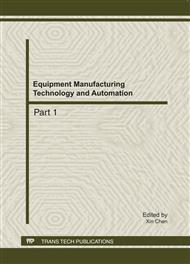p.1583
p.1590
p.1594
p.1598
p.1603
p.1609
p.1614
p.1621
p.1627
Design and Analysis of a Distributed Multi-Leaves and Large-Deformation Flexible Hooke Hinge
Abstract:
Flexible hinge is a typical flexible element in compliant mechanisms. But in the micro area, the design of flexible Hook hinge is rare. Compared with the traditional gap-type flexure hinges, flexure hinges with curve leaf are more prone to large deformation in functions direction under the load. And through the rational design, overall error of whole body with flexure hinges with curve leaf would be reduced to a minimum. So this article uses the curve leaf as the basic unit to construct a distributed multi-leaves and large-deformation flexible Hooke hinge. In view of the hinge structure is complex and very difficult to get accurate model, the model of flexible hinge Hook is establish by pseudo-rigid method to analysis the deformation of flexible hinge Hook under pure torque load. Theoretical analysis and nonlinear finite element analysis results are very close, proved that the construction of pseudo-rigid body model is correct. The results also show that this new type of distributed multi-leaves and large-deformation flexible Hooke hinge can provide the larger two-dimensional rotating schedule, and center drift of rotation is small. So this flexible Hooke hinge is a new type of large deformation flexible Hook hinge and line with the basic rotation characteristics of Hooke hinge.
Info:
Periodical:
Pages:
1603-1608
Citation:
Online since:
August 2011
Authors:
Keywords:
Price:
Сopyright:
© 2011 Trans Tech Publications Ltd. All Rights Reserved
Share:
Citation:


